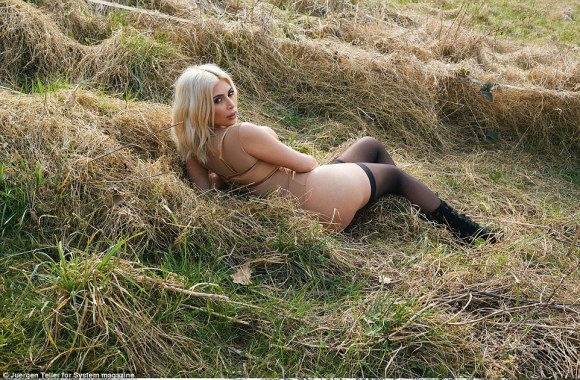WALTER BENJAMIN
The Work of Art in the Age of Mechanical Reproduction
My Critical Studies essay will be based upon the following quote from “The Work Of Art in the Age of Mechanical Reproduction” by W. Benjamin
IV
An ancient statue of Venus, for example, stood in a different traditional context with the Greeks, who made it an object of veneration, than with the clerics of the Middle Ages, who viewed it as an ominous idol. Both of them, however, were equally confronted with its uniqueness, that is, its aura. Originally the contextual integration of art in tradition found its expression in the cult. We know that the earliest art works originated in the service of a ritual—first the magical, then the religious kind. It is significant that the existence of the work of art with reference to its aura is never entirely separated from its ritual function.5 In other words, the unique value of the “authentic” work of art has its basis in ritual, the location of its original use value.
Prehistoric Venus
The Czech prehistoric sculpture known as the Dolni Vestonice (Vestonicka Venuse) is the oldest known work of terracotta sculpture in the world. Belonging to the genre of Venus figurines carved predominantly during the era of Gravettian art, this astounding item of prehistoric art was found at a Stone Age settlement in the Moravian basin south of Brno, in the Czech Republic. Like the famous Venus of Willendorf (c.25,000 BCE), the Venus of Dolni Vestonice now resides in the Vienna Natural History Museum. Although recently exhibited in the Mammoth Hunters Exhibition (2007) at the National Museum in Prague, and at the Prehistoric Art in Central Europe exhibition in Brno, this exquisite example of mobiliary art is rarely displayed in public, and whenever it leaves Vienna, it is usually accompanied by an armed escort.



VENUS
According to the classical poet Hesiod, Venus was conceived when Chronus castrated his father, the God Uranus, whose severed organs fertilized the sea. But Botticelli received additional inspiration from the Florentine poet, humanist and classical scholar Angelo Poliziano (1454-94), protege of Lorenzo Medici, who wrote about this scene in his epic poem “Stanze per la Giostra”.
No doubt Botticelli borrowed from these and other accounts. At any rate, The Birth of Venus depicts the moment when, having emerged from the sea in a shell, Venus lands at Paphos in Cyprus. She is blown towards the shore by Zephyrus – god of the winds – and the breeze Aura, while a Hora of Spring stands on dry land poised to wrap a cloak, decorated with spring flowers, around Venus to cover her nudity. A wistful gaze under heavy eyelids lends the goddess an air of cool distance. The fine modelling and white flesh colour gives her the appearance of a statue, an impression fortified by her stance which derives from the sculpture of ancient Greece – in effect, a more fluid version of the Medici Venus (Venus Pudica) (1st century CE, Uffizi Gallery, Florence) – a medium which was highly regarded in Florence at the time. Despite the slightly unusual dimensions of her body – the elongated neck and her overlong left arm – Botticelli’s Venus is an incredibly beautiful woman with smooth, delicate skin and golden curls. She is born to the world as the goddess of beauty, and the viewer is witness to this act of creation. As she lifts a foot to step off her gilded shell, the winds shower her with roses – each with a golden heart (according to mythology the rose flowered for the first time when Venus was born) – while the orange blossom on the tree in the middle ground is also fringed with gold.
The Birth of Venus, by Sandro Botticelli c. 1485–1486.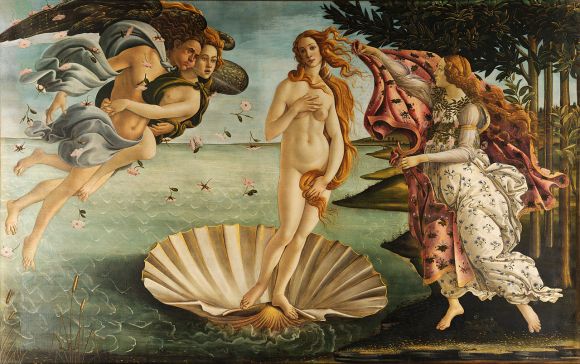
Analysis and Interpretation
A masterpiece of the Renaissance in Florence, and the first non-religious nude since classical antiquity, The Birth of Venus (Nascita di Venere) belongs to the group of mythological pictures painted by Sandro Botticelli (1445-1510) in the 1480s, following his return from Rome after completing three fresco paintingsin the Sistine Chapel for Pope Sixtus IV. The other mythological works include Pallas and the Centaur (c.1482, Uffizi Gallery, Florence), Venus and Mars(1483, National Gallery, London), and La Primavera (1484-6, Uffizi). Like these works, The Birth of Venus (1484-86) remains one of the profound treasures of the Florentine Renaissance. The work, painted with tempera on canvas, depicts the female nude figure of the goddess Venus standing on dry land having emerged from the sea. It was commissioned by Lorenzo the Magnificent (1449-92) of the Medici Family, whose quattrocento humanist circle was particularly interested in classical mythology, and marks the culmination of the revival of ancient myths, within the context of a humanistic Renaissance art. A perfect example of the type of picture targeted by the Dominican monk Savonarola, in his virulent 4-year campaign against profanity and frivolity (1494-8), the painting miraculously survived the monk’s “bonfire of the vanities” in 1497. This, despite its obviously pagan narrative and the fact it contained one of the first full length female nudes since the classical era. This good fortune enables us to enjoy one of the greatest Renaissance paintings by one of the most stylish of early Renaissance artists.
The Nude in the Middle Ages and the Renaissance
Venus and Cupid, ca. 1525–27. Lucas Cranach the Elder (German, 1472–1553) Oil on panel
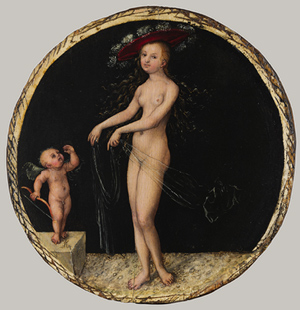
The development and eventual dominance of Christianity in late antiquity profoundly changed the needs of patrons and the output of artists. Unlike paganism, Christianity required no images of naked divinities, and new attitudes cast doubt and opprobrium on nude athletics, public bathing, and the very value of the human body. The early Christian emphasis on chastity and celibacy further discounted depictions of nakedness. In this climate, there was little motive to study the nude, and unclothed figures are thus rare in medieval art. Among the notable exceptions are Adam and Eve, whose story casts undress in an ominous light. In late antique works like the sarcophagus of Junius Bassus (ca. 359; St. Peter’s Grottoes, Vatican City), the ideal forms of Greco-Roman nudes are transformed into the first exponents of sin. The weakness and defenselessness of the naked man and woman are stressed in medieval art, and this tradition extends into the fifteenth century in such works as Giovanni di Paolo’s Expulsion from Paradise
VENUS DE MILO

This graceful statue of a goddess has intrigued and fascinated since its discovery on the island of Melos in 1820. Is it Aphrodite, who was often portrayed half-naked, or the sea goddess Amphitrite, who was venerated on Milo? The statue reflects sculptural research during the late Hellenistic Period: classical in essence, with innovatory features such as the spiral composition, the positioning in space, and the fall of the drapery over the hips.
The rediscovery of Greco-Roman culture in the Renaissance restored the nude to the heart of creative endeavor.
Contemporary work inspired by Venus
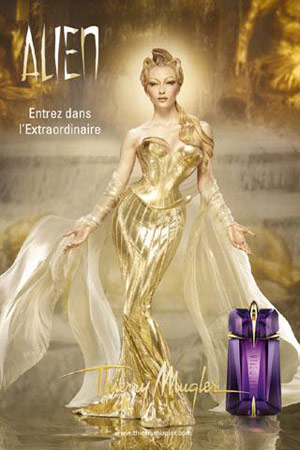
The spectacular advert for the new fragrance Alien by Thierry Mugler shows a siren or a goddess in gold. But in my humble opinion it’s mainly influenced by paintings showing the birth of Venus, the best know that by Sandro Botticelli to be seen in the Uffizi Gallery in Florence.
On BBC website I found very interesting documentary with Juergen Teller
He is talking about he fascination to the body (male and female) and about hi fascination to the skin, bones and fat on the body. I found very interesting how he photographed Vivienne Westwood in the pose which also remind me famous painting of Venus.
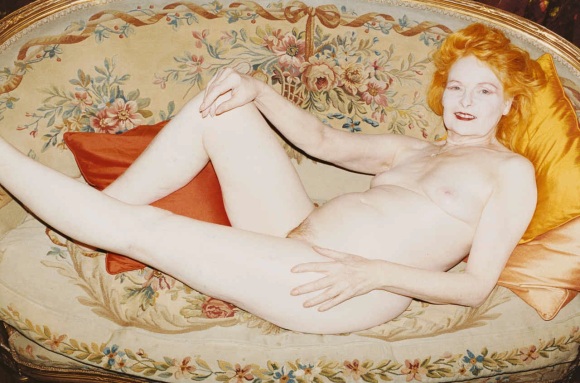
Juergen Teller – Dame Vivienne Westwood, au natural and un-retouched
SEX SELLS
There is no doubt about it: Sex Sells. In fashion alone, sexualised images are used to sell everything from scents to shoes. Nudity has become the norm. Rarely does a copy of Dazed, i-D or LOVE not expose a nipple, at least, in their fashion pages. The human form is beautiful. In particular the female body has been used for centuries as the epitome of beauty, from the Ancient Greek Venus de Milo to Botticelli’s The Birth of Venus, the female nude has been a constant epicentre of art.
Carine Roitfeld’s infamous campaign for Gucci by Tom Ford. The model has “G” for Gucci shaped from her pubic hair. Venus as we know her form the sculptures and painting doesn’t have a pubic hair.
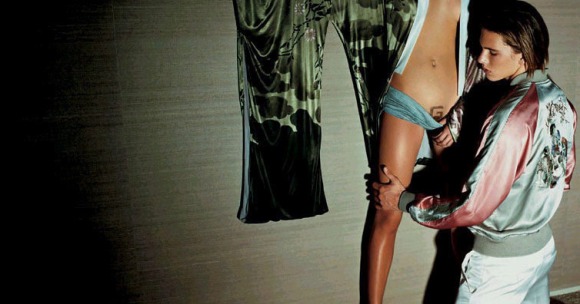
As old masters and painters used Venus, todays stylist, designers and photographers are still using it as a muse.
“However, instead of Venus being artistically perfected embodying innocence and vulnerability, she is now confident and electrically charged by her sexuality. Or at least that is what we are lead to believe. Fashion magazines are, generally, read by women. Therefore the nudity gracing the pages of Vogue should be used as a form of art, to enhance the clothing and create visually impacting spreads. ”
Juergen Teller is not afraid to use nudity as a form of art in his fashion photography. In the ad which he did for Marc Jacobs he uses Victoria Beckham as and object – fashion object with naked legs using only big bag and shoes. His images are raw and honest, don’t make women look like goddess.
Juergen says “Nudity is the most natural form of how you are…as I am doing a lot of fashion photographs, I am very used to clothes and what they do and what that means, and how everything you wear means something in the world.”
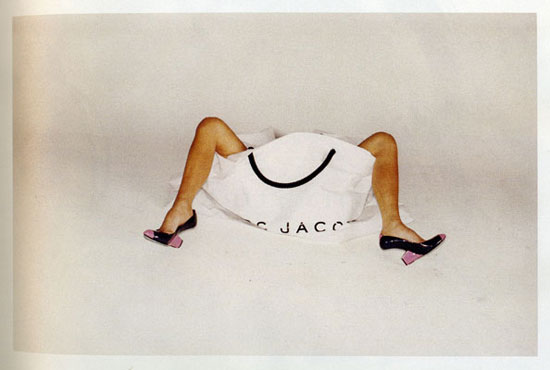
Juergen Teller
Model Kate Moss
“Nothing tastes as good as skinny feels” – Kate Moss is not shy of revealing her form in front of many.
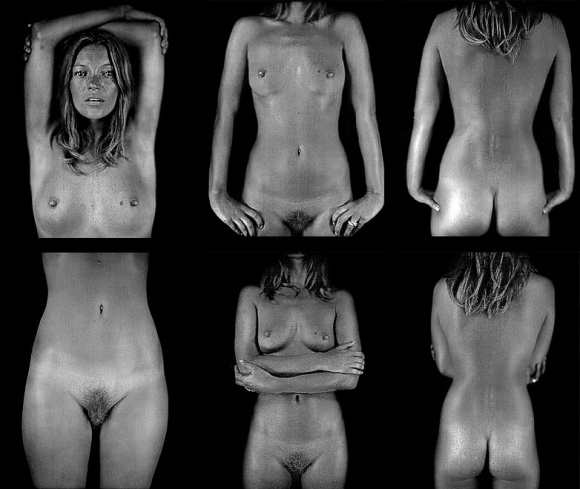
Chuck Close
Kate Moss
Moss also talks about how uncomfortable she was posing nude when she was young. Remembering her now classic photo shoot with Corinne Day for The Face, Moss says, “I see a 16-year-old now, and to ask her to take her clothes off would feel really weird. But they were like, If you don’t do it, then we’re not going to book you again. So I’d lock myself in the toilet and cry and then come out and do it. I never felt very comfortable about it. There’s a lot of boobs. I hated my boobs! Because I was flat-chested. And I had a big mole on one. That picture of me running down the beach—I’ll never forget doing that, because I made the hairdresser, who was the only man on the shoot, turn his back.”
HELMUT NEWTON, MASTER OF EROTIC FASHION PHOTOGRAPHY
Helmut Newton (1920 – 2004) was a German-Australian photographer. He was a “prolific, widely imitated fashion photographer whose provocative & erotically charged black-and-white photos were a mainstay of Vogue and other publications.
Born in Berlin in 1920 to a wealthy Jewish family, Helmut Newton was a delicate child prone to fainting. When he was around 8 years old his brother began showing him the ‘gutter’ of Berlin, a red light district which was inhabited by prostitutes like the ‘Red Erna’, who wore thigh length boots and carried a whip. Helmut remembers, “my eyes were poppin’ out of my head.” At 12 he saved his money to purchase his first camera at a “five-and-dime”. A few years later he decided to travel abroad and become a famous photo reporter. “In 1936 I arranged to have myself thrown out of school as a hopeless pupil,” says Helmut. With the help of his mother, Helmut began working as an apprentice for Else Simon, a female fashion-and-portrait photographer. His father’s prophetic response to the chosen path was, “My boy, you’ll end up in the gutter.”
Fashion Photography
A fashion photograph is, simply, a photograph made specifically to show (or, in some cases, to allude to) clothing or accessories, usually with the intent of documenting or selling the fashion. Photographs of fashionable dress, in existence since the invention of photography in 1839, are not fashion photography. The distinguishing feature-and the common denominator in the enormous diversity of style, approach, and content-is the fashion photograph’s intent to convey fashion or a “fashionable” lifestyle. At the end of the twentieth century, the Calvin Klein advertisement featuring only Calvin’s portrait changed the very definition of a fashion photograph from a picture of the featured clothing to the selling of a glamorous lifestyle identified with a specific logo
Femininity (alsocalled feminity, girlishness, womanliness or womanhood) is a set of attributes, behaviors, and roles generally associated with girls and women. Femininity is often perceived as a social construct, which is made up of both socially defined and biologically created factors. This makes it distinct from the definition of the biological female sex,as both males and females can exhibit feminine traits. People who exhibit a combination of both masculine and feminine characteristics are considered androgynous, and feminist philosophers have argued that gender ambiguity may blur gender classification.
Traits traditionally cited as feminine include gentleness, empathy, and sensitivity,though traits associated with femininity vary depending on location and context, and are influenced by a variety of social and cultural factors.In some non-English speaking cultures, certain concepts or inanimate objects are considered feminine or masculine (the counterpart to feminine).

Jean-Paul Goude, 1978
“He notes about that picture that “…unless you are extraordinarily supple, you cannot do this arabesque.
The main point is that Grace couldn’t do it, and that’s the basis of my entire work: creating a credible illusion.””
Sex sells? It can make you forget what is being advertised, say scientists
New research has a surprising conclusion for advertising executives: sex can put potential customers off buying a product
The adage “sex sells” has guided the advertising world for centuries.
Back in 1871, a naked “maiden” adorned the packaging of Pearl Tobacco, quickly followed by rivals who inserted cards in packs that showed scantily clad women. They went on to become market leader.
In recent years, the message was reinforced when Eva Herzigová, the model, gazed down from giant posters in Wonderbra’s Hello Boys campaign.
However, new research has a surprising conclusion for advertising executives: sex not only “does not sell” but can even put potential customers off buying a product.
The reason is that people pay so much attention to the graphic material their minds are distracted from what is being promoted.
Prof Brad Bushman, a psychologist of Ohio State University, said: “Our findings have tremendous applied significance, especially for advertisers.
“Sex and violence do not sell, and in fact they may even backfire by impairing memory, attitudes and buying intentions for advertised products. Advertisers should think twice about sponsoring violent and sexual programmes, and about using these themes in their ads.”
The study found that viewers are less likely to remember adverts when they are shown around films and programmes with explicit sexual or violent content than during family friendly material. The same goes for graphic adverts, say the researchers.
Violence had the greatest influence, with brands advertised during this genre of programme remembered less often, evaluated less favourably and less likely to be bought than products plugged alongside other media.
Brands advertised during programmes with sexual overtones were also viewed less favourably. Prof Bushman said: “We found almost no evidence that violent and sexual programmes and ads increased advertising effectiveness.
“In general, we found such programmes, and ads with violent or sexual content, decreased advertising effectiveness.”
The findings, published in the journal Psychological Bulletin, suggest advertisers may do better if the adverts have a G-rating, which means they are appropriate for a “general audience”.
Prof Bushman and lead author Robert Lull, a PhD candidate at Ohio State University, examined the reaction of 8,489 adults within 53 studies carried out in 2014 to measure the influences of violent and sexual content on advertising effectiveness with regards to brand memory, brand attitudes and buying intentions.
Researchers found that violent or sexual content in advertisements themselves had no significant effect but in studies when media content and advertising content were similar, viewers were more likely to remember them and had a stronger intention to buy the product.
The conclusion was that while violence and sex attract attention, it is at the expense of surrounding content that is neither violent nor sexual.
CONTEMPORARY BEAUTY IDEALS
Venus end of 2015
Lack of diversity within the industry has always been an issue, but it seems that this year, we’ve seen a significant push for greater representation. Between the popularity of the #DropThePlus movement and trans model Hari Nef signing with IMG, it appears that fashion is steadily becoming fairer. Below is a rundown of this year’s breakthrough diversity moments and here’s hoping for further advancement in 2016.
“Reclining Female Nude” by Pierre Auguste Renoir
